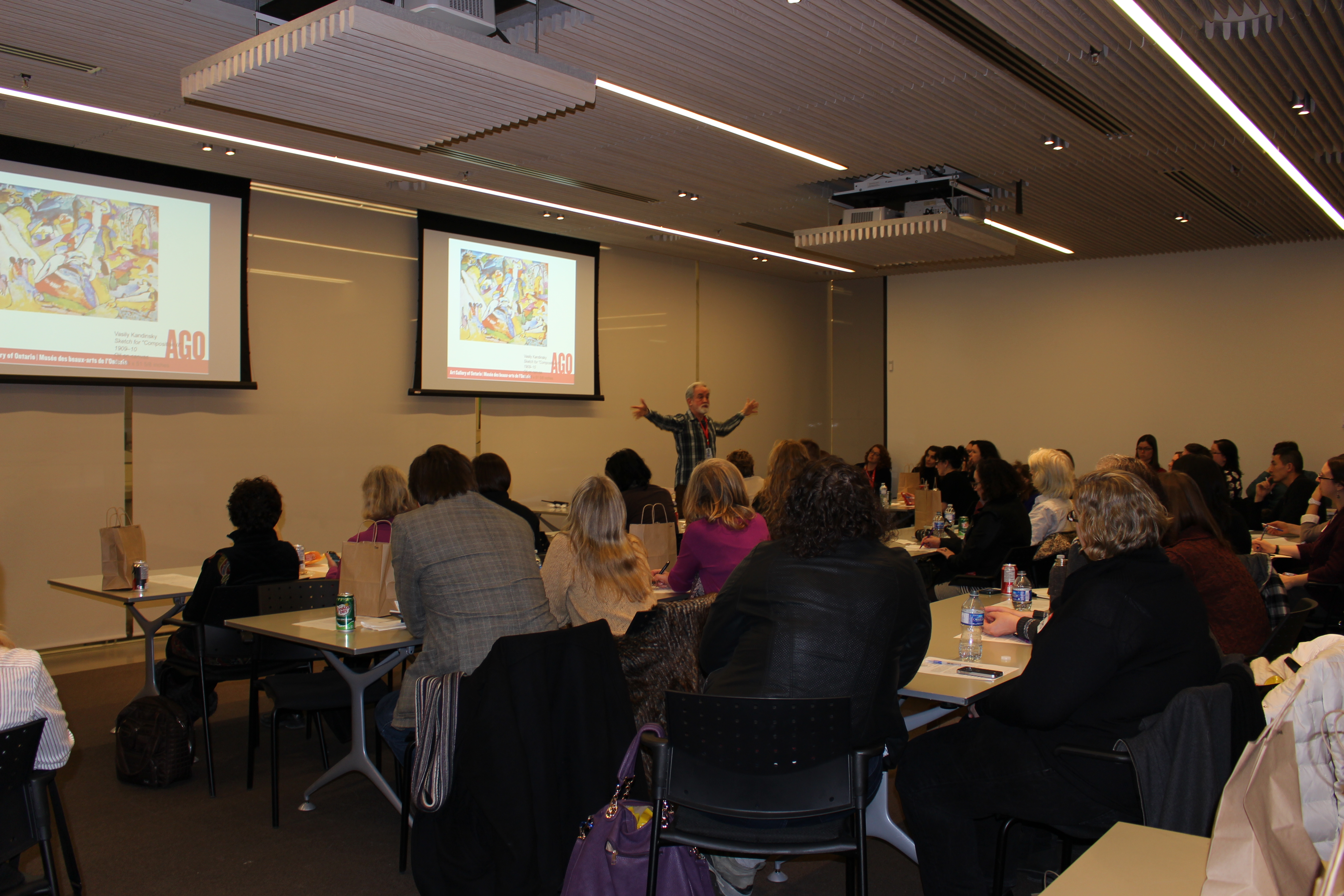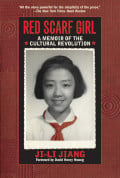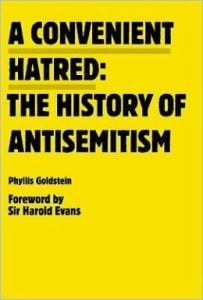Recently, Facing History and Ourselves and the Art Gallery of Ontario co-sponsored a workshop for the exhibit “The Great Upheaval.” This exhibit was on loan from the Guggenheim Collection and focused on European artists during 1910-1918. As a teacher, I was interested in this workshop for two reasons: to learn more about these artists and to discover new strategies to incorporate art into my teaching practice.
Infusing your Classroom with Colour: Facing History at the AGO
Posted by Cheryl Payne on March 10, 2014
Topics: Art, Professional Development, History, workshop, Strategies, Lesson Ideas, big paper
Terrific EdTech Tips: Top 5 Posts from Facing History's Tech Blog
Posted by Ben Gross on December 18, 2013
Topics: Professional Development, Choosing to Participate, Human Rights, Facing History Resources, Identity, History, Technology, Best of..., Lesson Ideas, Holocaust and Human Behaviour, Social Justice
Our group spent a good bit of time walking around Warsaw and seeing its sites. The first thing to realize about Warsaw is that it is an old looking but newly constructed city. Our guides said that the Germans destroyed at least half the city when they captured it in 1939. The destruction of the Warsaw Ghetto in 1943 after the suppression of the Rebellion accounted for 10 per cent more destruction and the failed uprising of August - October 1944 destroyed another 25 per cent and depopulated what had been a city of 1.3 million. We saw a film of the destruction in the Museum of the Warsaw Uprising and the visual record is a stunning one. Entire neighborhoods were obliterated and less than 1000 lived amidst the rubble. Two hundred thousand Poles, some of them Jewish survivors of the Warsaw Ghetto Uprising, lost their lives--many simply shot randomly on street corners (marked throughout the city).
Topics: Professional Development, History, Genocide and Crimes Against Humanities Course, Personal history
Human Resources: Holocaust and Human Behaviour Summer Seminar
Posted by Michael Grover on June 28, 2013
As an educator I have found that FHAO’s greatest resources are their human resources. Over the past few years I have been very fortunate to get to know each of the members of the Toronto Office, and as such have found a wealth of knowledge and support through them that I have been able to bring into my classroom. The Toronto Office runs a variety of workshops (such as the Bully Film Workshop, Literature Workshop, and the Facing History Urban Education Workshop, to name a few) that I have found invaluable in my personal and professional development. They run workshops that are immediately relevant to both our curriculum and our students. They deliver the information in pedagogically relevant ways, modelling wonderful new and creative tools and strategies as they take us through new and interesting (and though sometimes disturbing, frequently uplifting!) content.
Topics: Professional Development, Facing History Resources, Holocaust and Human Behaviour
Rethinking Teaching is Hard but Rewarding: Some Thoughts on Facing History's latest workshop
Posted by Jack Lipinsky on May 29, 2013
Being a teacher keeps me thinking and growing all the time. It seems that as I age, my skills must get ever nimbler even as my legs fail to keep pace. I find that I am spending more and more time reflecting on how to create lessons that have a lasting impact, which leaves me less time to prepare the actual lesson. To speed the process, I needed a rubric for reflection--and Facing History's wonderful workshop on Urban Education that took place on 27 May was the perfect prescription. I want to share the highlights with you!
Topics: Professional Development, Urban Education
Avoiding Victimhood: enticing our students to think critically about Genocide
Posted by Jack Lipinsky on April 21, 2013
My last couple of posts have focused on the educational methodology of teaching media savvy students how to examine visual evidence of the Shoah. I have recorded some of our class conversations and you must wonder: what is the atmosphere like in this classroom? Is it terribly negative considering what is being learned? Mustn't it be especially upsetting for students in a Jewish day school to learn the horrific details of the Shoah, the Holocaust, that wiped out an entire Eastern European civilization? My students find this study enlightening and are not depressed but eager to learn more and empowered by what they discover. I would like to share how this can be done. For me, this is an issue that transcends ethnicity, nationality, or religion. How are students affected by learning about genocidal attempts that strike 'close to home"? Let me begin with a story that exemplifies what Facing History is all about.
Topics: Professional Development, Genocide and Crimes Against Humanities Course
I recently completed a Guidance AQ with a heavy focus on counselling methodologies. In one session we previewed Solution Focused Counselling and in another Bereavement Counselling was the focus. Whereas Solution Focused Counselling relies heavily on the Active Coping Strategy concentrating on Problem Focused Coping including Cognitive Decision Making and Direct Problem Solving and Bereavement Counselling focused on Support Seeking Coping Strategies such as Support for feelings (CCSC & HICuP, 7), in both the importance of teaching coping strategies was highly emphasized. It became clear to me that the need to teach our students effective coping strategies is important (for further on this, see “Eight Important Reasons for Teaching Kids Healthy, Brain-based Coping Skills in School”).
Topics: Professional Development, Strategies
As mentioned in my previous post, doing professional development with Facing History has been a very transformative experience for me as an educator. Many teachers attend PDs, seminars and workshops, and quite often, there is not much follow-up afterward, but with Facing History, the staff ensures that they provide resources and follow-up with teachers attending their seminars.
- A Convenient Hatred: The History of Antisemitism, by Phyllis Goldstein
This a wonderful resource from Facing History, but the fact that it is a Facing History resource is not the reason I include this book. Goldstein’s A Convenient Hatred provides a detailed explanation of the history of antisemitism and how it has adapted and persisted through time. This book has been an invaluable resource to me in helping to answer that recurring question: “Why did [they] hate Jewish people?” In fact, if I once had trouble answering that question, I now have troubling keeping my answer to that question to an accessible chunk.
As a classroom resource: the book is extensive in its purview of the subject and can be, as such, integrated into almost any history course (from ancient to modern studies). Moreover, being a Facing History publication, there are numerous resources available for using the book in the classroom. Of particular worth, I would advise taking a free online workshop associated with the text. The next begins March 15, 2013. - The Rape of Nanking: The Forgotten Holocaust of World War II, by Iris Chang
In The Rape of Nanking Iris Chang provides not only a detailed account of the events and their context, but she also offers a profound explanation for the motivation of the Japanese soldiers during the invasion of China. This book graphically details the horrors of human behaviour, broadens our understanding of World War II, demonstrates the effects of unchecked institutionalized discrimination, and details the politics of denial.
As a classroom resource: the writing is accessible intermediate academic and senior academic and applied readers. Of particular note for use in the classroom are Chang’s explanation of the profound effect of institutionalized discrimination on the behaviour of individuals (see “The Motives Behind Nanking,” pp. 54-59 and the classroom reading guide), and Chang’s address of the continued denial(see Chapter 10) of the event by the Japanese and the politics surrounding our ignorance of it in the West, a relevant theme to all discussions of genocide. The book includes graphic documents (primarily but not limited to photographs found between pages 146 and 147) of the atrocities that are incredibly thought provoking for mature students, but must be very carefully selected and reviewed with consideration to students’ capacity to deal with them (and the parents willingness to have them viewed by their children). It is worth noting that the stories and images Chang encountered while writing this book led her into increasingly deeper depression and, eventually, to suicide; this knowledge serves as a profound reminder that as we deal with human atrocities, we must consider and allow time to address our students’ own emotional reactions to these events. Iris Chang gives a historical overview and shares her insights into the Japanese military invasion of Nanking at http://vimeo.com/21218528.
- Extraordinary Evil: A Brief History of Genocide, by Barbara Coloroso
If Coloroso’s Extraordinary Evil can be described as reductionist in its approach to and description of genocide vis a vis bullying, it can nonetheless also be conceived of as a wonderful resource for teachers of genocide to help students connect with material that can be so difficult to conceptualize. Coloroso’s writing is accessible to high school students and the connections she makes are directly relevant to the school context. She makes a point of discussion and an argument for understanding how our actions matter, even on a small scale. She makes an excellent argument for the role of the upstander (Facing History defines an upstander as someone who takes a stand against injustice), and why that role is not one that should be conceived of as a contextual one, but rather a pervasive attitude and behaviour.
As a classroom resource: her discussion of the Bully Circle (pp. 83-84) is interesting and one that I have found helps students develop empathy. While few students can truly connect with the tragedy of a genocide, almost all students can relate to bullying. Having students make this connection (see page four of the activity attached for classroom application) through role play can be very effective, but, as always, we must know our class. If we suspect someone in the class is being bullied, having that person participate could be incredibly demeaning. Furthermore, in the consolidation of our role play, it would be good to emphasize that just because we can empathize with being bullied, does not mean we can (nor do we want students to) fully understand what it means to be a victim of a genocide. Role play is fun and develops empathy. Just make sure it remains role play! Coloroso’s website provides additional resources for discussing roles in bullying at KidsAreWorthIt.com. - War Without Mercy: Race and Power in the Pacific War, by John Dower
In War Without Mercy, Dower takes a close look at World War II and compares the nature of racism and warfare in the two primary theatres of the war: the European theatre and the Pacific theatre. In analyzing various data, he quickly notes that [for the Americans] the battles in the Pacific were far more brutal than those in Europe. Building on this, he argues that while in the European theatre there was a sense of shared humanity even between opposing soldiers, the racist attitudes that soldiers in both Japan and America were taught (and taught is the key word here) regarding the enemy heavily influenced the subsequent treatment of the enemy. Dower focuses on the media’s role (through songs, propaganda, cartoons, and film) and influence in propagating racist attitudes. Though the language of the text is at times a bit too academic for the applied classroom in which I teach, his discussion of the media’s influence over how we think and behave is an accessible and worthy topic to engage in the classroom.
As a classroom resource: while I find the text is a bit dense, Dower includes a wonderful section of very accessible graphic documents such as magazine cartoons that very clearly depict “The War in Western Eyes” and “The War in Japanese Eyes”(pp. 180-200). Students engage with these quickly and with facility, and the documents provide a wonderful opportunity to teach students Document Based Questions, an important skill to develop and an imperative for the AP classroom (see image guide handout for classroom use). As a springboard to further inquiry, there is a wealth of related documents readily available to review as well. In particular, Merrie Melodies / Loonie Toons’ "Censored Eleven" (see video guide handout for classroom use) provide a unique insight into how stereotypes and racist ideas are taught to even the youngest audiences, though one should use discretion in approaching these documents in the classroom. Always contract for a safe space, provide students with context, explain your purpose and allow sufficient time to debrief challenging materials. Also, be ready to provide victim voices and positive depictions to balance negative portrayals of any identity. Lastly, know your students and their parents. - Cognitive Surplus: How Technology Makes Consumers into Collaborators, by Clay Shirky
While Shirky’s Cognitive Surplus does not directly address the issues of genocide or discrimination, this text is a wonderful resource for transforming our students from passive recipients of information to active upstanders, and can guide us as teachers through this process. Shirky details how the rise of the computer and the internet in the 21st Century has dramatically changed how people engage media. His key point, as the title suggests, is that people have demonstrated a measurable change in their patterns as consumers, moving away from a model of passive recipients of media products (e.g. television) to one of active producers (an amusing example he points to is LOL Cats). Shirky lists several examples (moving beyond LOL Cats) of how this shift in the control of production means that as individuals, we now have more control to produce good than at any point in history.
As a classroom resource: the first example Shirky lists to this end is Ushahidi, a site whose name means ‘testimony’ or ‘witness’ in Swahili. This is a web based program that has relied on the contribution of volunteers to spread awareness of events. Designed during the social upheavals in Kenya in 2007-2008, Ushahidi demonstrated a huge influence over political behaviour, and was operated at an individual level (for further information see Texting Talk). Ushahidi is a wonderful example of how individuals can be upstanders, and how as upstanders they can effect change. Jumping off from Ushahidi, we can explore other Web 2.0 tools (such as Glogster, Prezi, Bubbl.us, etc.) to produce our own multimedia products, use social networking sites (such as Facebook, My Space, Google+, etc) and employ online publishing tools (Wordpress… ironic emoticon here) to effect social change. Other prominent examples of sites dedicated to the harnessing of positive collaborative power include Change.org, DonorsChoose.org and Kickstarter.com.
For a succinct review of the book, see Shirky’s TED Talk on Cognitive Surplus.
Topics: Books, Professional Development
August 15-19, 2011 was a transformative week for me as an educator as I had the honour of attending Facing History ‘s “Holocaust and Human Behaviour” Seminar in Toronto.
Topics: Professional Development




